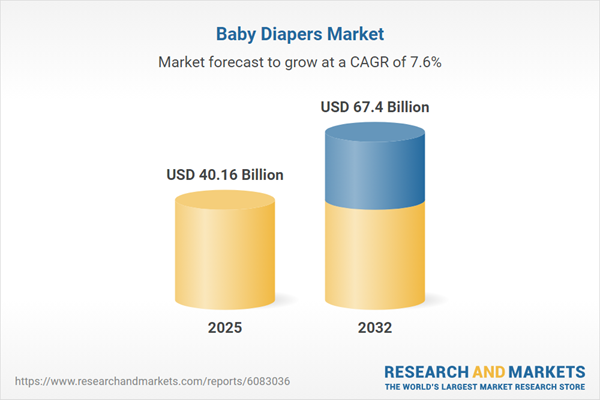Speak directly to the analyst to clarify any post sales queries you may have.
The baby diapers market is rapidly evolving in response to shifting consumer expectations, regulatory requirements, and technological innovation. Senior leaders must navigate rising demands for comfort, sustainable materials, and reliable supply, all while capitalizing on new market channels and responding to industry transformation.
Market Snapshot: Baby Diapers Market
The baby diapers market expanded from USD 37.50 billion in 2024 to USD 40.16 billion in 2025 and is projected to reach USD 67.40 billion by 2032, reflecting a CAGR of 7.60%. This growth highlights rising global demand, increased focus on premium product attributes, innovation in material science, and enhanced digital and omnichannel strategies.
Scope & Segmentation
This report delivers comprehensive analysis and forecasts across key aspects of the baby diapers industry. Market segmentation covers:
- Diaper Types: Disposable Diapers, Non-Disposable Diapers, Closed Diaper, Open Diapers
- Product Formats: All-in-one Diapers, Swim Diapers, Training Diapers
- Material Types: Biodegradable Materials, Cotton Cloth, Hybrid Materials, Polyethylene Films, Super Absorbent Polymers
- Sizes: Double Extra Large (XXL), Extra Large (XL), Large (L), Medium (M), Newborn, Small (S)
- Packaging Sizes: Jumbo Pack, Multiple Packs, Single Pack
- End-Users: Clinics, Daycare Centers, Home Usage, Hospitals
- Distribution Channels: Offline, Online
- Regional Coverage: Americas (United States, Canada, Mexico, Brazil, Argentina, Chile, Colombia, Peru), Europe (United Kingdom, Germany, France, Russia, Italy, Spain, Netherlands, Sweden, Poland, Switzerland), Middle East (United Arab Emirates, Saudi Arabia, Qatar, Turkey, Israel), Africa (South Africa, Nigeria, Egypt, Kenya), and Asia-Pacific (China, India, Japan, Australia, South Korea, Indonesia, Thailand, Malaysia, Singapore, Taiwan)
- Company Analysis: Abena A/S, Attends Healthcare Products, Inc., Chiaus (Fujian) Industrial Development Co., Ltd., Daio Paper Corporation, Domtar Corporation, Drylock Technologies, DSG International Limited, Essity AB, First Quality Enterprises, Inc., Hengan International Group Company Limited, Humble Group AB, Johnson & Johnson, Kao Corporation, Kimberly-Clark Corporation, Medline Industries, Inc., Ontex Group NV, Pigeon Corporation, Procter & Gamble Co., The Honest Company, The SCA Group, Unicharm Corporation, Unilever PLC
Key Takeaways for Senior Decision-Makers
- Consumer priorities are increasingly balanced between comfort, skin health, and environmental impact, requiring strategic product development and targeted messaging.
- Advancements in material technology and design are enabling thinner, more absorbent, and environmentally responsible diaper formats, enhancing brand differentiation and institutional relevance.
- Omnichannel retail expansion, including subscriptions and direct-to-consumer models, is strengthening brand loyalty and informing faster product iterations.
- Supply chain complexity and regulatory compliance are intensifying, prompting investments in supplier diversification, traceability, and local manufacturing capacity.
- Segment-specific solutions—from premium offerings in North America and Asia-Pacific to flexible compliance in Europe, Middle East & Africa—drive market access and competitive positioning.
- Successful companies couple robust innovation with disciplined fulfillment strategies, creating a platform for sustainable, profitable growth in this segment.
Tariff Impact on Supply Chains and Pricing
United States tariff changes in 2025 placed significant pressure on the baby diapers supply chain. Input costs for polymer films and absorbent materials increased, leading manufacturers to accelerate supplier qualification, pursue alternative sourcing, and consider reshoring production. These shifts drove procurement teams to expand vendor rosters and adopt cost-reducing logistics. In parallel, institutional buyers tightened contract terms to navigate price variability and maintain service reliability, while manufacturers explored packaging and shipment consolidation to optimize landed costs.
Research Methodology & Data Sources
The research utilizes primary interviews with procurement leads, R&D managers, and institutional buyers, as well as technical consultations with materials experts. Claims are validated through regulatory guidance, trade documentation, and published standards. Analytical frameworks map supply risk, logistics, and channel performance, with cross-stakeholder validation for balanced insight. This process ensures actionable and reproducible results for strategic planning.
Why This Report Matters
- Enables manufacturers and retailers to align innovation, sourcing, and distribution strategies with evolving regulatory and consumer requirements.
- Helps healthcare and institutional buyers evaluate supply partners and product specifications in a complex and dynamic landscape.
- Supports policy and procurement professionals with insights into material breakthroughs, supply risks, and channel opportunities.
Conclusion
The baby diapers market landscape is shaped by innovation, regulatory requirements, and consumer expectations. Organizations that integrate material advancements, resilient supply sourcing, and agile channel strategies will sustain growth and reduce risk as sector dynamics accelerate.
Table of Contents
3. Executive Summary
4. Market Overview
7. Cumulative Impact of Artificial Intelligence 2025
Companies Mentioned
The companies profiled in this Baby Diapers market report include:- Abena A/S
- Attends Healthcare Products, Inc.
- Chiaus (Fujian) Industrial Development Co., Ltd.
- Daio Paper Corporation
- Domtar Corporation
- Drylock Technologies
- DSG International Limited
- Essity AB
- First Quality Enterprises, Inc.
- Hengan International Group Company Limited
- Humble Group AB
- Johnson & Johnson
- Kao Corporation
- Kimberly-Clark Corporation
- Medline Industries, Inc.
- Ontex Group NV
- Pigeon Corporation
- Procter & Gamble Co.
- The Honest Company
- The SCA Group
- Unicharm Corporation
- Unilever PLC
Table Information
| Report Attribute | Details |
|---|---|
| No. of Pages | 192 |
| Published | November 2025 |
| Forecast Period | 2025 - 2032 |
| Estimated Market Value ( USD | $ 40.16 Billion |
| Forecasted Market Value ( USD | $ 67.4 Billion |
| Compound Annual Growth Rate | 7.6% |
| Regions Covered | Global |
| No. of Companies Mentioned | 23 |









